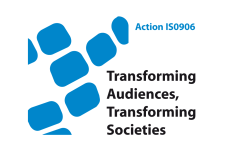- About the Action
- Events
- PhD workshop - Ljubljana 2014
- Action Open Conference - Ljubljana 2014
- New Media and Participation conference - Istanbul 2013
- Belgrade meeting 2013
- Media literacy research and policy - Brussels 2013
- ICA Pre-Conference 2013
- Tampere meeting 2013
- Budapest workshop 2012
- Milan meeting 2012
- Brussels PhD workshop 2012
- Brussels Action workshop 2012
- London meeting 2011
- Zagreb Conference 2011
- Lisbon meeting 2010
- Affiliated events
- WG 1
- WG 2
- WG 3
- WG 4
- Cross-WG
- Output
Communication modes as key elements of converging media environments
Hasebrink, U., & Hölig, S. (2011). Communication modes as key elements of converging media environments . Zagreb conference: "New challenges and methodological innovations in European media audience research". 7-9 April 2011.
Abstract: This proposal takes up one of the points of departure for the work of WG 1, i.e. technical convergence and hybridization of media genres and formats. Current information technologies afford a wide range of different communication services. As a consequence the conventional distinction between mass and interpersonal communication including their ascribed functions, e.g. providing news and information, or management of individual relations, is challenged: Nowadays several forms of group communication, user generated content or personal publishing have to be considered. All these forms are arranged on the continuum between the two poles of mass and interpersonal communication, and they often are combined into communicative hybrids. To be up to this challenge we propose the concept of communication modes (Hasebrink 2004), which refers to the user’s definition of a usage situation as a specific form of communication. It is assumed that this definition of what is going on in the respective communicative situation has significant consequences for the processing of the respective information and for the realized functions. In a current empirical project (see Hoelig/Hasebrink 2009) this concept is applied to internet usage: The aim is to explore the interrelation between different information needs and communication modes. In their everyday lives users have various information needs concerning a) general orientation, b) certain topics, c) social network interests, or d) individual problem-oriented issues. According to several studies the technical infrastructure of the internet is used to gratify each of them. But yet it is not clearly understood, according to which criteria users make differences between different forms of internet-based communication and their respective functions. In order to identify these criteria, we conducted a study using an open card sorting method combined with think aloud protocols: Subjects were asked to sort different forms of communication with regard to their functionality for certain information needs. The results show how different information needs are correlated with certain patterns of user’s activities, communication partners, addressed and achieved audience as well as the temporal distance – patterns, which we interpret as communication modes, which structure the multiple functional options of the convergent communicative space of the internet.

